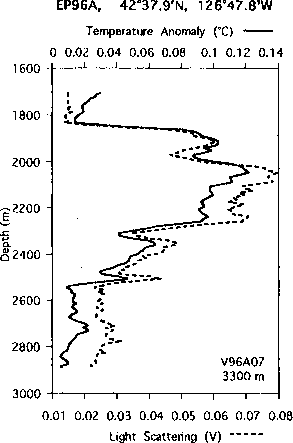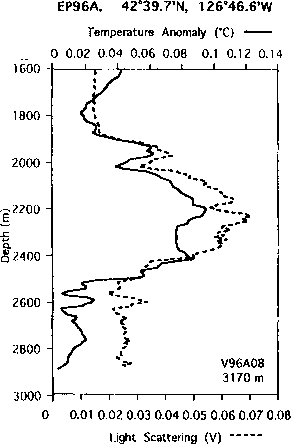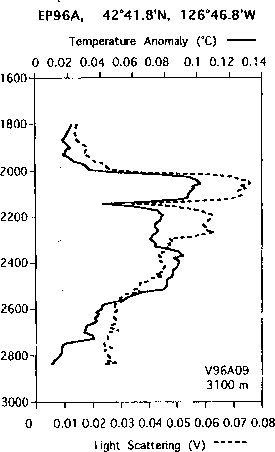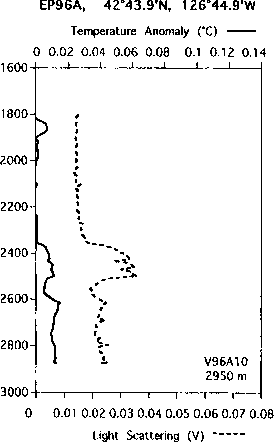Cruise Report from NOAA Ship McARTHUR
3/11/96 1430 PST Report From Ed Baker on McArthur
On March 10, 1996, the Gorda Ridge Eruption Assessment Team (GREAT) confirmed that hydrothermal discharge on the northern Gorda Ridge has been profoundly perturbed by recent magmatic activity. This confirmation was supplied by the discovery of a large event plume, EP96A, centered near 42ø40'N, 126ø47'W. Initial survey work indicates the event plume, which may be an agglomeration of more than a single event discharge, has a maximum thickness of approximately 700 m, a maximum diameter of approximately 10 km, and a maximum temperature anomaly of about 0.12øC.
Upon reaching the northern Gorda Ridge at 1200 on March 8th, GREAT began a series of vertical CTD casts starting at 42ø26.2', 126ø55.3, and proceeding northward along the ridge axis at approximately 2 nm intervals. Tow-yoing was impossible because only 3100 m of wire (2900m useable) was available on the winch. No plume signals were detected on the first six casts, although up to 1 km of the water column remained below the deepest CTD depths reached. At station V96A07, 42ø37.9', 126ø47.8', temperature and particle plumes were found between 1850 m and 2800 m above a bottom depth of 3300 m. The main plume lens was centered between 1850 m and 2300 m, with several thinner and less intense plumes below. Light scattering and temperature profiles agreed closely. The plume distribution was similar at the next two stations northward, 8 and 9, though the overall plume thickness thinned and became less intense. At Station 10, 42ø43.9', 126ø44.9', plumes were found only below 2400 m. At station 11, 42ø39.5', 126ø44.3' (2 nm east of station 8), thin plume horizons were found at 2025 m and 2200-2300 m. Station 12, 42ø40.4', 126ø49.2', 2 nm west of station 8, a plume similar to that of V96A07 was found, perhaps indicating advection of the plume to the west in the 24 hours between stations 7 and 12.
We presume that most of the major plumes detected so far are event plumes, based on their exceptional height above the axial valley. Without tow-yoing capability it will be difficult to demonstrate the vertical and horizontal symmetry characteristic of event plumes. At the least, it seems we have mapped several distinct event plumes that differ in depth and in horizontal and vertical dimensions. One alternative hypothesis is that all, or some, of the plumes are chronic plumes originating high on the valley walls. Future chemical and microbiological analyses will help to test various hypotheses.
No substantial near-seafloor plumes (e.g., of the scale encountered in association with event plumes at Cleft and CoAxial) have been found. The source of the presumed event plumes may be to the south of their present position in water too deep for our present equipment to reach, farther to the north where we have not yet samples, or beneath their present position but as yet undetected by us.
Our primary objectives are to substantiate the plumes so far detected as event plumes, and to locate the seafloor source(s) of ongoing chronic plumes. We expect to continue working north of the V96A07 location, in the shallowest portion of the northern Gorda Ridge.
Gorda Ridge Eruption Assessment Team
Dr. E.T. Baker
Dr. M. Bertram
Dr. R. Collier
Mr. R. Greene
Dr. D. Kelly
Mr. G. Lebon
Mr. G. Massoth
Mr. K. Roe
Ms. M. Summit
Ms. S. Walker




